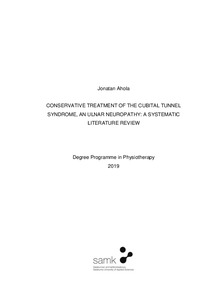Conservative treatment of the cubital tunnel syndrome, an ulnar neuropathy: a systematic literature review
Ahola, Jonatan (2019)
Ahola, Jonatan
2019
All rights reserved. This publication is copyrighted. You may download, display and print it for Your own personal use. Commercial use is prohibited.
Julkaisun pysyvä osoite on
https://urn.fi/URN:NBN:fi:amk-2019120825400
https://urn.fi/URN:NBN:fi:amk-2019120825400
Tiivistelmä
The purpose of this thesis was to find the current evidence concerning conservative treatment of the cubital tunnel syndrome. Essential theoretical background was firstly provided, consisting of anatomy of the ulnar nerve and cubital tunnel, definition of the cubital tunnel syndrome with typical clinical presentations, examination, diagnostic studies and current treatment methods, both conservative and surgical.
A systematic literature review was then conducted. The search process was carried out in three databases: PubMed, Science Direct and PEDro. Two methodological quality assessment tools, PEDro scale and MINORS, were then applied to the selected studies. Four studies were accepted and shortly summarized in a table. Results were provided and concluded according to current best evidence.
This systematic literature review found that, current evidence suggests that patient ed-ucation and activity modification is the best available conservative treatment method for mild to moderate cubital tunnel syndrome. Additional nigh time splinting could be considered. However, the current literature does not agree on its positive quantity. Lastly, nerve gliding exercises and steroid injections were not supported currently for the treatment of cubital tunnel syndrome.
A systematic literature review was then conducted. The search process was carried out in three databases: PubMed, Science Direct and PEDro. Two methodological quality assessment tools, PEDro scale and MINORS, were then applied to the selected studies. Four studies were accepted and shortly summarized in a table. Results were provided and concluded according to current best evidence.
This systematic literature review found that, current evidence suggests that patient ed-ucation and activity modification is the best available conservative treatment method for mild to moderate cubital tunnel syndrome. Additional nigh time splinting could be considered. However, the current literature does not agree on its positive quantity. Lastly, nerve gliding exercises and steroid injections were not supported currently for the treatment of cubital tunnel syndrome.
